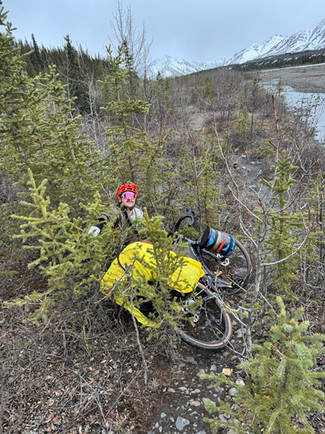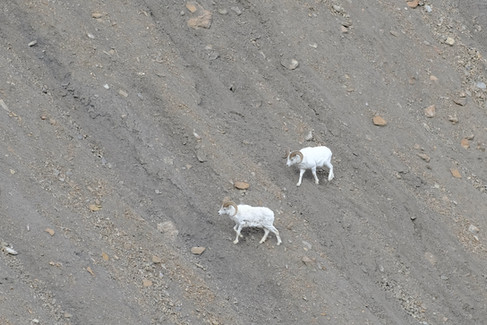Denali Park Road Bikepacking
- Luke
- May 18
- 7 min read
Updated: May 18
The Road and the Landslide
The Denali Park Road is a 92-mile access route through Denali National Park and Preserve in Alaska—world-renowned for its stunning views of wildlife, landscapes, and Denali (Mt. McKinley), North America’s tallest peak—normally only accessible by tour bus or limited personal vehicle permits. Since August of 2021, the road has been closed at mile 43 due to the Pretty Rocks landslide, which has primarily been driven by melting permafrost and rainfall. Contrary to common knowledge, the landslide has been active since the 1960s, and recent accelerations in sliding are what caused the road’s closure.
The landslide poses an interesting conversation. Since the road’s closure, wildlife reports have skyrocketed from travelers who go beyond the closure by foot or bike. So the dilemma: fix the road for vehicles and tourists, or keep Alaska wild and reserved only for those who have the gumption to explore it. That’s for you to decide.
The Plan Takes Shape
Here begins the adventure! On a little bit of a whim and some free time, Brian brought up the idea of bikepacking the Park Road. Since bikes could take a detour around the road closure and have the latter half of the road all to themselves, this seemed like quite a good idea! Neither of us had bikepacked before, but how hard could it be?! Planning to go mid to late May, Brian called up the ranger station to make sure the road was free of snow and open. The ranger was all positive with great reports of a completely cleared road and ready to go. In hindsight, I believe this was because they wanted us to do all the scouting and work for them. However, with this news, we were a go!
The Journey Begins
We headed up the night before our planned departure and made a brief pitstop at the cabin for the night. The next morning, we set off on the old dusty road again, having very little clue what was in store for us. The ride was pessimistic, with a decent amount of rain and copious amounts of snow; we were definitely in store for a cold and wet trip. Arriving at the park, we began the process of obtaining a backcountry permit for camping. Who knew there were so many rules for pooping in the woods? Either way, we assembled our gear and tested out the equipment we would be riding for the next 5 days. Definitely should have done that beforehand, but we’re busy folk, and there’s no better time than the present! We set off at 3:30 in the afternoon, and by 3:35, our legs were on fire! The first 12 miles or so were all uphill. Brutal stuff for us new bikepackers. But, as they say, what goes up must come down!
Wildlife and Wonder
The next few hours were something else. We were hit by sporadic rainfall, but it’s tough to be down when you’re in such a beautiful place. Vast, open valleys leading up to gorgeous snow-speckled mountains. Something that’s special about Denali is the wildlife. Having been Alaska-grown and raised, both Brian and I have seen our fair share of wildlife. Yet not to this level. I kid you not, we probably saw a couple hundred ptarmigan on just that stretch. Also, a small group of caribou that were completely unperturbed by our presence. It’s their world, and we’re just traveling through it.
About 30 miles later, we set up camp on the banks of the Teklanika. It was one of the few areas that were clear of snow and not visible from the road. As we set up camp, Brian kept grumbling about his beef with the park service, something about them not letting us use their perfectly clear and open campgrounds and locking all their restrooms, forcing him to poo in the woods. We had a late dinner and went to bed to steady rainfall, fully anticipating a wet and cold next day.
Climbing to the Closure
The next morning met us with clear skies and boosted spirits. We had 12 miles to the road closure, so we set off as soon as we broke camp. The climb up to Sable Pass was killer on the legs but heaven on the eyes. Beautiful mountain valleys and snow-covered terrain. The ptarmigan had been joined by tons of squirrels, and every few hundred feet, there would either be a ptarmigan barking at us for disturbing its peace or a group of ground squirrels running around frantically as if we had stolen their lunch. The amount of snow was disconcerting and making our detour around the landslide seem less and less doable.
The Detour Struggle
We arrived at mile 43, where the road was closed. By the looks of it, there were lots of snow, creeks, and brush in our path. Both of us were a little disgruntled that we couldn’t just bike through the construction zone, but eventually just accepted that we’d be in for some suffering and gave it the old college try. We started off gingerly, trying to preserve our dry feet. That did not last long, however. The beginning was a choice between rotted-out knee-deep snow or rotted-out knee-deep snow and alders. We decided to go with just the snow. Every step was a new surprise: have enough flotation to stay on top or crush through slushy, wet snow and get a shoe full of ice. Without the bikes, it would have made for tough going. With the bikes, it made for tough going while also having to push a bike and 50 pounds of gear through 3 feet of snow. Brian had opted for the trailer on this trip. The trailer was great for the road but acted as a ski groomer in the slush and snow. Not great stuff!
A mile or so in, we hit a patch of snow that was strong enough to hold our weight. Sweet relief, for a little bit. We made it past the point before the landslide and soon realized why the construction crew didn’t allow bikers or pedestrians. The landslide was huge, yes. It looked as if half the mountain had sloughed off into the valley. That wasn’t the impressive part, though. Looking up, hanging precariously off the side of the mountain was a steel truss bridge—or part of it, at least—looking at any moment like it could fall and come toppling down the mountain at us. Incredible stuff being done by that construction crew, to say the least.
Beyond the Landslide
Continuing on, we had several snowbridges and then the trek out of the valley. By this time, we were both soaked from the thigh down and decided to forgo struggling through snow, bushes, and tundra, and just walk up the stream. Wet? Yes. Freezing? Also yes. But at least we were moving. The climb out of the valley was the worst part. Alders, alders, and steep hills with more alders speckled with more snow. Real fun stuff! Not! Following hours of struggling to travel 4.5 miles, we finally hit the park road past the closure. It was beautiful. The sun was shining, and the road looked a little clear close to Polychrome Pass. We decided to give it a go and see how far we could get. Turns out, not that far. Initially, the road only had a couple of snow patches to plow through. As we went further, though, and elevation rose, we soon hit points where the road was covered in knee-to-thigh-deep snow for as far as the eye could see. Climbing to a nearby vantage point confirmed our suspicions that this was as far as we’d go. Even though we did not make it all the way to the end of the road, making it as far as nature allowed us to was a good feeling in itself.
Nature Reclaims
Given that we had time and were past all the ruckus of tour buses and construction equipment, we headed back toward the landslide from the far end. Instantly, we were hit with more wildlife. Not even half a mile, and we were seeing groups of sheep. The road was unmaintained at this point, and nature had begun to reclaim what was rightfully hers. Small rockslides, probably caused by the sheep, had begun to fill in the road again. What originally was a path carved into the side of a mountain was beginning to fade into the background.
Camping was limited on the road, so we decided to venture back down the way we came to find a decent spot. We set up camp and were treated to a gorgeous sunset, a wily fox, and good times. It had been almost a 12-hour day of struggling; much like our bikes, we were two-tired to continue and needed sleep to tackle the next day.
The Return Journey
The next morning was spectacular. Over the past few days, the park had given the forecasters a run for their money. Rain was the only thing predicted, and for the majority of the trip, we were rain-free! Early morning, we woke to the sun heating the tent. It had dropped below freezing during the night, but by 7 a.m., the tent felt almost room temperature. We packed up our gear and planned for a long day ahead. Previously, we had gingerly hopped from bank to bank, trying to minimize water exposure; now that was out of the question. We instead opted to bike down the river—yes, like down the actual river. Should have brought paddles and life jackets! The freezing temperatures and our early start made the snow crossings far better, and within a couple of hours, we were back on the road. Only 45 miles to go.
Crushing the Passes
One by one, we crushed each pass. Our bikes ate those hills for breakfast. Following Sable Pass, we quickly refueled and changed socks at Igloo Creek and continued on our way. The wildlife showings continued, and we saw a grizzly munching on some bushes on the shores of the Teklanika. Primrose Ridge fell to the same fate as Sable Pass beneath our tires. And with each long uphill was a cruise of a downhill. Climbing out of Savage River Valley, we had the last 10 or so miles all downhill. It was a hoot.
The Finish Line
Fifty miles later that day, we were finished. Over 100 miles in all, pedaling through the rugged expanse of Denali National Park leaves an indelible mark on the soul. The road delivers raw beauty and untamed wilderness that are seldom found elsewhere. Get the goods in before the whole road opens up again! Though unpleasant, the detour provides access to nearly 50 miles of premium gravel road, shared only by those willing to make the trek on bikes or feet. No cars, no buses, no tourists. Keep Alaska Wild.



































































